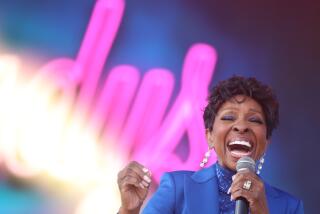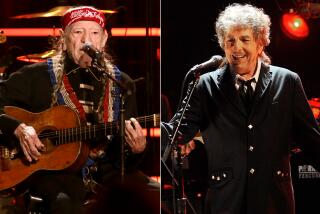In Newport Rocker Reprise, Dylan Just One of the Folks
NEWPORT, R.I. — After 37 years away, Bob Dylan brought it back home Saturday to the Newport Folk Festival and reminded an audience of old fans and new that the times are not only a-changin’--they’ve changed.
The 61-year-old singer-songwriter made no mention of the fact that he was returning to the festival for the first time since 1965, when he startled the music world as a skinny, bushy-haired 24-year-old by taking the stage with an electric guitar.
For the record:
12:00 a.m. Aug. 9, 2002 For The Record
Los Angeles Times Friday August 09, 2002 Home Edition Main News Part A Page 2 National Desk 4 inches; 178 words Type of Material: Correction
Bob Dylan photo--In Sunday’s Section A, the photographer’s credit was omitted from the photo of Bob Dylan performing at the Newport Folk Festival in 1965. David Gahr was the photographer.
At Newport in 1965, Dylan signaled a new age in pop culture by fusing the commentary of folk music with the energy and dynamics of rock ‘n’ roll.
By doing so, he helped change rock ‘n’ roll from a simple, teen-directed sound into an art form through which young songwriters could express themselves with intelligence and imagination.
It was a courageous move for Dylan because he was already hailed as the great young hope of folk music, thanks to a series of songs, such as “The Times They Are A-Changin’ ” and “Blowin’ in the Wind,” that linked him with the classic tradition of Woody Guthrie. By moving to rock, he risked losing his already considerable audience.
Indeed, some of the folk crowd at Newport reacted with boos. But Dylan would go on to new heights of popularity, and rock itself was forever changed. Everyone from John Lennon to Bruce Springsteen has cited Dylan’s move into rock ‘n’ roll as a major influence on their own musical development.
As 10,000 spectators watched Saturday from lawn chairs or on picnic blankets, and perhaps 1,000 more from a flotilla of boats in Newport Harbor, there were no jeers--only cheers--as Dylan, wearing a cowboy hat, alternated almost song by song between his acoustic and electric guitars to perform such standards as “Desolation Row,” “Mr. Tambourine Man” and “Positively 4th Street.”
As evening settled on a sun-baked day, Dylan performed four encores to cap a two-hour show. He and three other band members pounding away at electric guitars for a rollicking “Like a Rolling Stone,” then replacing all four guitars with acoustic models to play “Blowin’ in the Wind.”
But what once were protest songs now had a crowd that included former Vice President Al Gore and actor Richard Gere waving their arms and dancing on the lawns outside the Civil War-era Ft. Adams.
The producers of the festival said Dylan insisted they make no fuss about his “return” when he agreed to come back this spring, asking them to “treat this as another gig.” Indeed, the May press release announcing details of the three-day event mentioned first that it had a new sponsor--a fruit juice company--before listing the “roster of talent” and naming Dylan, Shawn Colvin, Arlo Guthrie, Dar Williams and others, with no reference to this being the headliner’s first trip here in 37 years.
*
Just Another Gig
In effect, it was just another “gig” for Dylan, who has been on a busy tour with his band and performed Friday night an easy drive away, in Worcester, Mass.
Nor was Dylan returning to the exact turf where he performed in 1965. Back then, the concerts were staged on a field mostly used for drying fishing nets. The festival now is held at Ft. Adams State Park, on Newport Harbor, with the $55 tickets good for a full day of music on several stages--though performances on the others ceased before Dylan went on in the late afternoon.
Yet, however much Dylan might have wanted it to be a routine appearance, it was anything but that for a crowd that included some of the key players in the events of 1965, and many others who claimed to have been there, though those numbers--as with other such defining moments in pop culture--tend to grow over the years, as do the tales of what happened.
Dylan performed five songs that 1965 night, but accounts of what happened vary with the witness. Was folk music’s elder statesman, Pete Seeger, really so enraged that he nearly took an ax to the cable electrifying Dylan’s music? Was the booing because of Dylan’s new sound or because he got off the stage so quickly? Was there actually that much booing?
In fact, promoters say, Dylan was supposed to perform only a few numbers in 1965. In the manner of festival concerts at the time, a dozen performers had to be on and off the stage in little more than two hours. Dylan’s electrified sound wasn’t a surprise to the organizers, either.
The Minnesota-born songwriter had quickly become a star in the Greenwich Village folk scene in New York but had shown signs of what would be a lifetime of musical experimentation by releasing his rock ‘n’ roll single “Like a Rolling Stone” shortly before the festival.
Still, many in the crowd were not ready for what they heard that night, when Dylan--in a black leather jacket and with the Paul Butterfield Blues Band at his side--performed a sizzling “Maggie’s Farm.”
He sang, “I try my best to be just like I am.../...But everybody wants you to be just like them.../...They say, ‘Sing while you slave’.../...I just get bored.../I... ain’t gonna work on Maggie’s farm no more.”
Then he launched into angry riffs on the electric guitar, a counterpoint to the pretty voices and folk harmonies that had come before.
*
Fans ‘Totally Confused’
“The audience was totally confused,” George Wein said in an interview just before this festival. Wein, 76, founded the festival in 1959 and is the executive producer. He recalls some cheers then for Dylan but also shouts of “sellout.”
Wein was the one who tried to calm Seeger, the banjo-playing activist who had worked for years to preserve the traditions of folk music, which was replete with protest songs but done in earnest, mournful tones.
Seeger did not have an ax, Wein said, but he did complain, “That noise is terrible.”
Wein said he met Dylan coming off the stage and told the young songwriter, “You have to go back.... Do something acoustic.”
Dylan obliged with two more songs, ending with “It’s All Over Now, Baby Blue.”
At a time when folk groups like Peter, Paul & Mary were powerful commercial forces, and rock’s British invasion, led by the Beatles, was still cresting, Dylan’s performance was “a farewell to the idealism and the purity of the folk revival,” Wein said.
As he sees it, Dylan was telling his young folk fans “who had resisted the mainstream tastes of their friends” that the new realm of plugged-in rock “was no longer taboo.”
To Peter, Paul & Mary’s Peter Yarrow, who served as master of ceremonies much of the night, the event signaled the emotion behind the emerging youth culture that was pushing for a “greening of America” and rebelling against a materialistic society seen as phony, mean-spirited and cruelly hierarchical. To them, folk music, with it’s unadorned guitar chords, represented “speaking from the heart, an authentic exchange,” Yarrow said.
Yes, there was booing, Yarrow says, but also “shocked silence--gasping and silence.”
Nearly four decades later, Yarrow said it’s clear that those fans booing, though honestly feeling betrayed at the time, were wrong to view electric sound as dooming authenticity. Performers such as Springsteen have shown “it’s absolutely not a matter of instrumentation,” Yarrow said. “It’s a matter of the heart.” In addition, it’s often the rock stars who today lead social causes, as folk artists once did.
But if some didn’t like what they heard from Dylan in 1965, others embraced his new sound.
“It turned an important corner for those of us at a certain age,” said Arlo Guthrie, the son of Woody Guthrie and the headliner of today’s conclusion of the festival. “We wanted to be able to express ourselves in a modern format ... to continue the evolution of folk music and not have it be a static academic exercise ... rather than play it back like a parrot.”
The festival had a picnic-like atmosphere Saturday, with patrons--some arriving by ferry--carrying their own chairs or blankets and wandering by rows of tents selling everything from lobster rolls to tie-dyed peace-symbol T-shirts.
Though most of the concert-goers had not been born when Dylan last appeared, others swapped memories of “the last one.”
For Barry Lipnick and his wife, Louise, this was--as for Dylan--a first trip back to Newport since 1965. They were in their “early 20s” then, and “now we’re older,” said Barry, wearing khakis, sandals and a floppy hat.
“We’ve heard him many times in between,” said Louise, an elementary school teacher and mother of three, wearing purple nail polish and colorful loop bracelets on her wrist. She liked Dylan’s earliest songs best, “with their messages of peace and revolution.”
*
Dylan ‘Does What He Wants’
While the occasion was enough to bring them all the way from Seattle, they understood why Dylan might want to simply play his music and not acknowledge the moment.
“He does what he wants,” Barry Lipnick said, “as he always does.”
As he took the stage Saturday, Dylan remained a heralded figure in U.S. pop music. His last two albums, 1997’s “Time Out of Mind” and 2001’s “Love and Theft,” are among his most acclaimed. “Time Out of Mind” won a Grammy for best album of the year, and “Love and Theft” was nominated for the same award.
The media-shy performer did not meet with reporters here to discuss the landmark 1965 day. In an interview last year with The Times, however, Dylan spoke about being booed at Newport.
“You can’t worry about things like that,” he said then. “Miles Davis has been booed. Hank Williams was booed. Stravinsky was booed. You’re nobody if you don’t get booed sometime.”
*
Times staff writer Robert Hilburn contributed to this report.
More to Read
The biggest entertainment stories
Get our big stories about Hollywood, film, television, music, arts, culture and more right in your inbox as soon as they publish.
You may occasionally receive promotional content from the Los Angeles Times.










